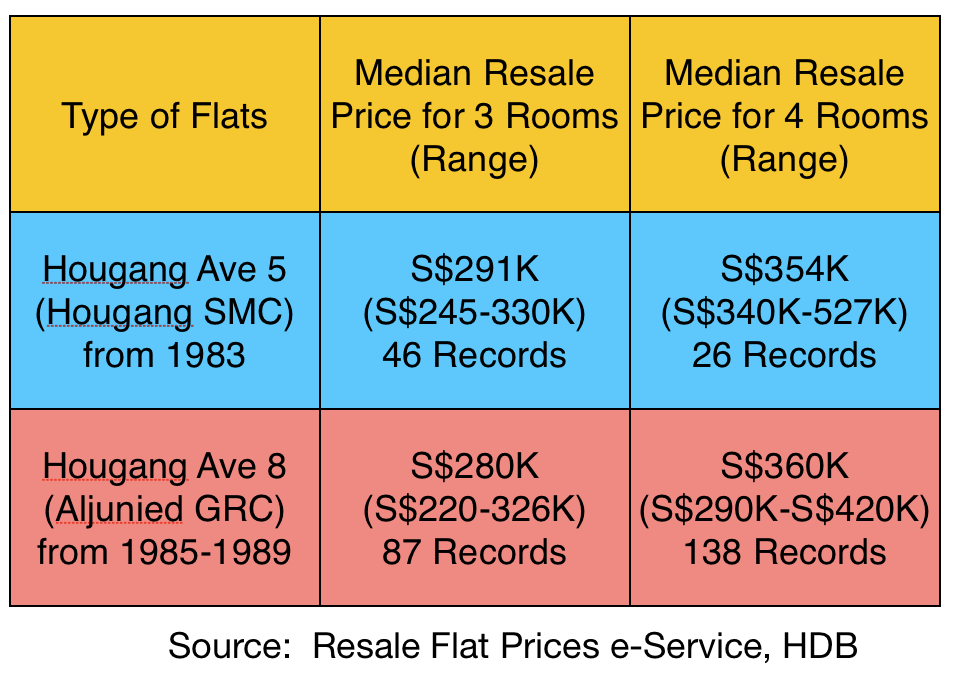Are Property Prices affected by who you vote for?
Recently, Minister Mentor Lee Kuan Yew mentioned that the property prices of Aljunied GRC will go down if the voters of that constituency vote for the opposition. In his words, “If you have the wrong government, your property prices go right down. Ask why in Hougang the property is not as high as their neighbours.” Given the residents of Hougang SMC has been voting for Mr Low Thia Khiang for the past 20 years and assuming Mr Lee’s comments to be true, the direct inference is that the value of the HDB flats for the Hougang SMC should now be far lower than similar flats in the same neighborhood placed under Aljunied GRC.
The best way to do this is to find out how the prices of the HDB flats in Hougang SMC and Aljunied GRC have fluctuated over the past twenty years. This dataset is difficult to collect and requires HDB to provide them. However, it turns out that we can look at the current 1-year resale transacted prices of flats in both areas and answer the question to a large extent. The aim of this HDB e-service is to “assist potential resale flat buyers and sellers in making informed decisions, taking into account the prevailing trends in the HDB resale market” (source: HDB). So, we did the following by looking at 2 sets of data: 3 room flats & 4 room flats from Hougang Ave 5 (under Hougang SMC) and Hougang Ave 8 (under Aljunied GRC) and computed the median prices. All transactions found in the data set are arms-length transactions which means that we exclude resale transactions that may not reflect the full market price, for example, I buy a flat from my parents at a reduced resale flat price. Hence HDB’s data is indicative of the real market prices. Here’s what we found:


From the above table, the resale flat prices did not vary signifcantly. In fact, although flats from Hougang Avenue 5 (under Hougang SMC) were older than those from Hougang Avenue 8 (under Aljunied GRC), they seem to fetch higher resale prices. Do note that the Ministry of National Development control both the demand and supply of public housing in Singapore. We all know that buying a flat is an important decision for most families. Hence it is reasonable for us to assume that a couple will examine all the factors which will affect the value of the flat they intend to buy, for example, accessibility to transport, amenities, the condition of the flat and the living conditions in the neighbourhood. If MM Lee’s assertion is true, very few people will buy flats in Hougang Ave 5 and consequently the resale prices of flats in Hougang Ave 5 should not be above those in Hougang Ave 8 under Aljunied GRC. The data seems to contradict what MM Lee has said about flats in Hougang SMC falling below flats in Aljunied GRC. Perhaps the ruling party can provide the facts and figures as to why they assert that property prices under Aljunied GRC will fall if the opposition party wins on May 7.
Other Interesting articles:
[1] Mr Wang, Property Values and Your Choice of Political Party
[2] Sze-Meng Soon, How Govt and MPs should tackle home affordability
[3] Tay Lay Kuan has extended my analysis on Hougang & Aljunied to Potong Pasir SMC & Toa Payoh-Bishan GRC. No evidence in MM Lee’s claims on HDB prices.
[4] You can read this research paper “The political economy of housing prices: Hedonic pricing with regression discontinuity” by Wong Wei Kang and Eddie Sue. Have a conversation with my former colleagues from Singapore Angle and the main results does not differ much from what I have computed.
[5] You can read another post Hougang constituency 4-room flats retain value well by Alex Au aka Yawning Bread that also indicate the prices for 4 room flats.
[6] Chong Kwek Yan & Giam Xingli published this interesting analysis entitled “No evidence that flats in Opposition-held wards are worth less” via Facebook using multiple comparisons tests. If I am still working as an academic (i.e. I practically have very little time because of the focus I put on my own start-up), that will be the same approach that I will have adopted and I will apply clustering theory to look at the data sets as well.